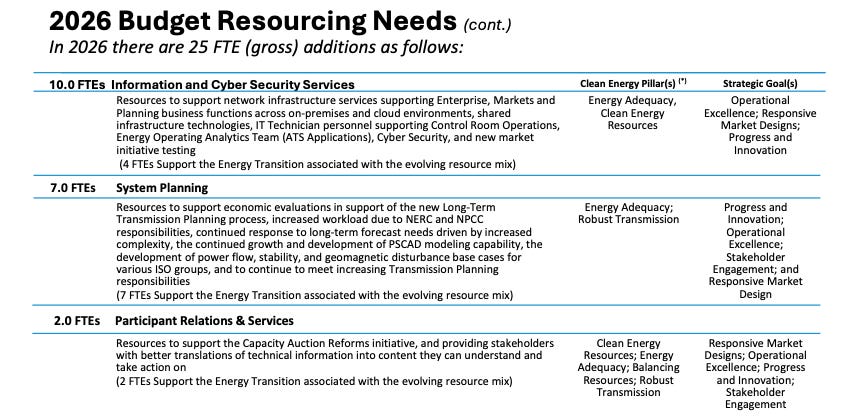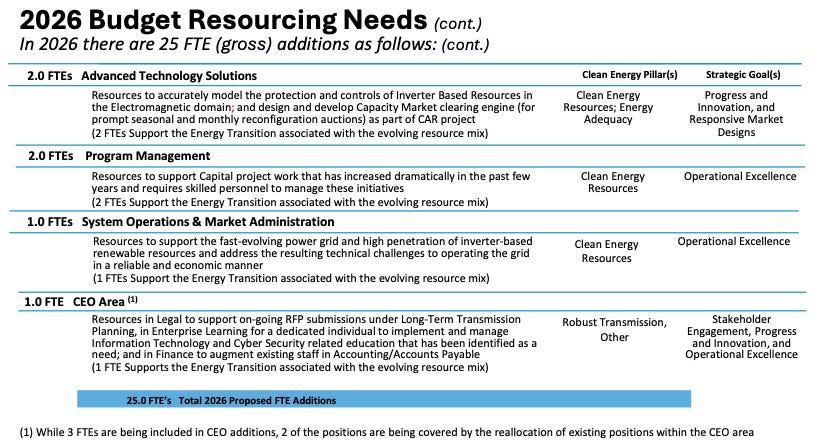[BONUS] One Fifth of ISO-NE's Staff is Retirement-Age
ISO-NE's 2026 budget has some bad news on staffing.
On 8 August 2025, ISO-NE released their Calendar Year 2026 Budget. It’s a net $21.9M (8.4% YoY) increase, of which $10.0M is earmarked to “Attract, Develop, and Retain Talent.”
This is prima facie reasonable. This money will go towards:
An additional 25 FTEs of staff
10 FTEs for IT, cybersecurity, and software testing
7 FTEs in transmission system planning: modeling, forecasting, and identifying what needs to be upgraded. NERC and NPCC have been asking more of these staffers lately.
2 FTEs for improving stakeholder engagement for the Capacity Auction Reforms. ISO-NE has a lot riding on the Prompt and Deactivation reforms, and a lot of people are complaining about ISO-NE staff not responding fast enough.
2 FTE for developing better tools for modeling inverter-based resources (wind, solar, batteries) and building market clearing tools for the Capacity Auction Reforms.
2 FTE for program management.
1 FTE for real-time system and market management to keep a better handle on inverter-based resources throwing wrenches into everything.
1 FTE to help reshuffle staff in the C-suite.
4% increase to the budget for merit raises
1.5% increase to the budget for promotion raises


ISO-NE’s Staffing Faces “Competitive Challenges.”
These adjustments to internal pay scales come out of a recently-completed salary survey from consulting firm Mercer. This survey includes approximately 100 utility companies among its respondents, which offers ISO-NE real points of reference, even for its niche technical staff. This survey work has revealed some “competitive challenges” to hiring and retention, like:
19% of the ISO-NE workforce is retirement-eligible
Everyone and their dog is trying to hire transmission engineers, because all the new generator and datacenter interconnections require engineers who can analyze their impacts. This has increased pay expectations dramatically.
About 1/3 of ISO-NE’s workforce has software and cybersecurity skills, which means they could get paid Big Tech dollars if they asked.1
ISO-NE has finally realized that the talent they want is in short supply and high demand, and that the problem will only get worse.
ISO-NE’s pay for “many specialized roles” lags behind the market median. I don’t think they have great data for some of their more unique roles, but it seems like they’re trading notes with the other ISOs, which are hiring even more furiously than ISO-NE is.
I need to say it again: One fifth of the ISO-NE workforce is retirement-age.
ISO-NE helpfully summarizes their conclusions like so:
For all of these reasons, it is essential that we maintain competitive compensation; doing so is a cost-effective measure that will help prevent additional turnover and ensure the Company does not experience vacancies that will hinder implementation of major initiatives or impact efficient operation of its systems and markets. [Emphasis mine.]
That word “additional” is a tell, in my opinion.
How Bad is that Pay, Really?
I mean, it’s not terrible.

This suggests a pretty linear distribution of salaries. Year-over-year, we’re looking at approximately 5% annual increases in pay for the overall staff and 6% annual increases in overall headcount. This is partially noticeable in the number of staff paid under $80k—an insult of a paystub imo—but particularly noticeable for staff paid above $160k. The number of people paid over $200k doubled over two years!
There are two potential stories in this graph:
ISO-NE realized a lot of their old-timers were too important to let retire. They scrambled to hire underqualified Zoomers and Millennials and then gave these old-timers hefty raises to stay on for 3-5 more years to train the new staff. 2
ISO-NE hired a bunch of geniuses at the top of their field, and then realized after the fact that they paid top dollar for people who were about to retire.
For everyone’s sake, I hope the first story is closer to the truth.
But let’s say you have the quantitative PhD and/or 7 years of AWS experience ISO-NE asks for some of their positions. You could be an individual contributor at Meta, or an energy trader at ICF, and those “my quantitative” positions pay a decent sum better than the offers implied by the above chart, even if ISO-NE sweetens the deal with hybrid work in Western Massachusetts.
I admit that recommending ISO-NE to increase their pay is motivated reasoning on my part. But the staff they want are thin on the ground. And even rubes like me, with our niche skillsets and mission-driven acceptance of pay cuts, are now flight risks.
I would know.
This post and the information presented are intended for informational purposes only. The views expressed herein are the author’s alone and do not reflect those of their current or previous employers or any elected officials. The author makes no recommendations toward any electric utility, regulatory body, or other organization. While certain information contained herein has been obtained from sources believed to be reliable, the author has not independently verified this information, and its accuracy and completeness cannot be guaranteed. Accordingly, no representation or warranty, express or implied, is made as to, and no reliance should be placed on, the fairness, accuracy, timeliness or completeness of this information. The author assumes no liability for this information and no obligation to update the information or analysis contained herein in the future.
Or as I framed it last December:
I figure [ISO-NE] would offer $75k-85k (gross before benefits) for a sharp kid fresh out of a UMass Amherst undergrad program…and they’d lose to Akamai offering that kid $120k plus stock options to work on something something AI.
Or as I framed it last March:
If your Extreme Old-Timer is a few years from retirement, there’s value in hiring their replacement “early.” Give the new hire a year or two learn from your EOT, so that they can identify all the holes and inefficiencies in your EOT’s workflow before your EOT retires to go skiing.




In a free market you allocate labor by paying people and providing better conditions. It’s a feature not a bug.
It's also not a free market. And if it were the speed at which markets correct isn't very helpful for people today.
“Markets can remain irrational longer than you can remain solvent.” - John Maynard Keynes